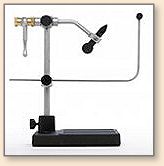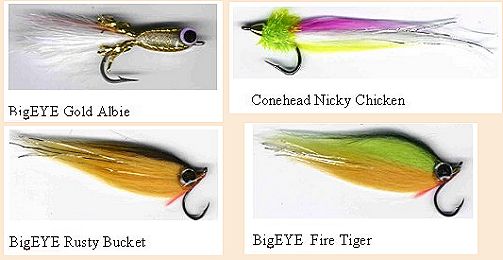It was June and the rains pelted us each day
with no let up. How much could this old ground
hold? The soil in North Carolina's Coastal Plain
is best for farming because it holds moisture. It
is a composite of decayed vegetation, deep black
topsoil mixed with layers of yellow clay. You'll
find drainage ditches just about everywhere. They
serve two purposes. They drain off the access water
that eventually finds its way into the Neuse River.
And, it solves the problem of mosquito infestation
which is nowhere near what I grew up with in Mosquito
Lagoon.
Running charters in this weather is pretty bleak.
There is so much fresh water that our saltwater
species act lethargic and won't bite anything,
let alone a fly. So naturally some time can
be spent replenishing those fly stocks. One
thing I have found is that the Borski Slider
works as well in these waters as it did in New
Smyrna Beach. In fact, it worked so well in
a couple of creeks that we limited out almost
every day on Flounder. But specs and redfish
wouldn't touch it and it got me thinking about
what Nicky Adams said one day.
"Why don't they make fly patterns like MirroLure colors?"
Of course my immediate response was something
like, "well we have these rules for how flies
are tied." Horse poopy! He stumbled on an
idea that I should have discovered myself. The
more I thought about this, the more it made sense.
Think about the popular lure patterns that catch
fish - why not!
My daddy used to use a Black/Orange lure called
the 'rust bucket.' It worked about 99 percent of
the time and it caught everything from Spanish to
Redfish to Speckled Trout. "Walk the Dog!" he'd
say to me. "Walk the dog."
I know it is hard to "walk the dog" with a fly, but
it can be done. I have tied probably over 2,000
deer hair flies and foam head poppers for some
outstanding popping action. These flies do similar
things like leaving long bubble trails, noise and
some of these poppers are so loud, they put the best
lures to shame.
 I tied so many flies one year that the ring on my
Renzetti Traveler broke. I called Lilly Renzetti
complaining about it. She asked me what size flies
I was tieing. When I ever told her that I tied
everything from #4s to 7/0 she gasped. "That vise
is only made for hooks up #28 to 4/0." Oops! I
came to find out that I was tieing flies that were
too big for that vise, but I still like it anyway.
That vise is light and the best in my opinion.
Sympathetic to my whining, Lilly sent me a Cam for
my traveler - now I was in heaven. It is just one
beautifully designed vise.
I tied so many flies one year that the ring on my
Renzetti Traveler broke. I called Lilly Renzetti
complaining about it. She asked me what size flies
I was tieing. When I ever told her that I tied
everything from #4s to 7/0 she gasped. "That vise
is only made for hooks up #28 to 4/0." Oops! I
came to find out that I was tieing flies that were
too big for that vise, but I still like it anyway.
That vise is light and the best in my opinion.
Sympathetic to my whining, Lilly sent me a Cam for
my traveler - now I was in heaven. It is just one
beautifully designed vise.
My old Renzetti is now 6 years old and still ticking.
I have tied another 700 flies since June. The greatest
revelation came from Nicky and I found that 5 color
patterns will work on most game fish in Eastern
Carolina from the Neuse River to Harker's Island.
These flies work great for everything from large
mouth bass to Albacore. Now that is saying a lot
for a fly. My favorite is the Nicky Chicken.
This fly is tied in three versions:
- Floating
- Submerged
- Sinking
The color patterns are shown here in the submerged,
BigEYE patterns. The flies, except for the submerged
version, are relatively easy to tie. The sinking is
the easiest because the dumbbell eyes are collared
with large ice chenille. The Floating flies are
spun deer hair and if you know what materials to
use this fly works extremely well when the fish
are hitting top water lures, "Walk the Dog."

All of these flies are made from Polar Fibre Hair,
except the Gold Albie and this is probably the
easiest fly to tie with Frizzy Fibre and Gold Mylar
Cord. The Conehead Nicky has a brass conehead
for weight and ice chenille collar with a hot pink,
white and electric yellow tail.
These flies really work and you'll have a great time
tying them. Well, it is back to the Renzetti for me.
Hey, it looks like the sun is coming out. Until next
time. ~ Capt. Doug
About Doug:
Capt. Doug Sinclair has relocated from New Smyrna Beach, Florida to
Grantsboro, NC. He specializes in fly-fishing and light tackle charters.
Doug charters the Coastal Carolina area of New Bern or Oriental.
Catch him on the web at
www.flyfishacademy.net or call him at (252) 745-3500.
|


 I tied so many flies one year that the ring on my
Renzetti Traveler broke. I called Lilly Renzetti
complaining about it. She asked me what size flies
I was tieing. When I ever told her that I tied
everything from #4s to 7/0 she gasped. "That vise
is only made for hooks up #28 to 4/0." Oops! I
came to find out that I was tieing flies that were
too big for that vise, but I still like it anyway.
That vise is light and the best in my opinion.
Sympathetic to my whining, Lilly sent me a Cam for
my traveler - now I was in heaven. It is just one
beautifully designed vise.
I tied so many flies one year that the ring on my
Renzetti Traveler broke. I called Lilly Renzetti
complaining about it. She asked me what size flies
I was tieing. When I ever told her that I tied
everything from #4s to 7/0 she gasped. "That vise
is only made for hooks up #28 to 4/0." Oops! I
came to find out that I was tieing flies that were
too big for that vise, but I still like it anyway.
That vise is light and the best in my opinion.
Sympathetic to my whining, Lilly sent me a Cam for
my traveler - now I was in heaven. It is just one
beautifully designed vise.